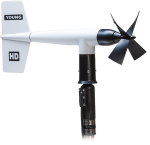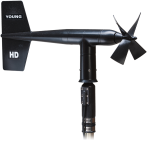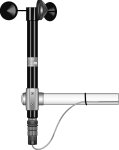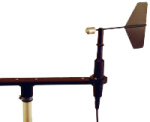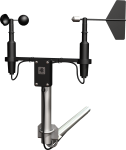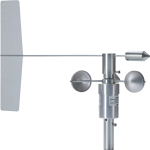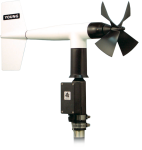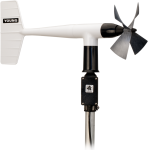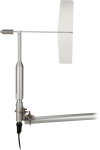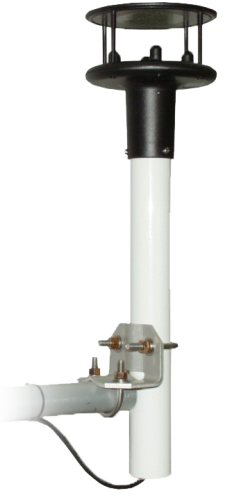
日常メンテナンスコストを最小限に抑える






概要
注意: このセンサに付属する取り付け器具は、センサを注文する Campbell Scientific の地域オフィスによって異なる場合があります。
続きを読む利点と特徴
- 低メンテナンス- 可動部品がないため、メンテナンス費用と時間を大幅に削減
- 検出可能な最小風速は毎秒0.01メートル
- SDM-SIO1Aとの互換性により、1台のデータロガーで測定できるセンサの数が増加
イメージ



詳細
仕様
| アプリケーション |
|
| センサ | 2 次元超音波風速計 |
| 測定の説明 | 風速と風向 |
| 入力電圧 | 9 ~ 30 Vdc |
| 一般的な電流消費量 | 約 15 mA (継続) |
| 動作湿度範囲 | < 5% ~ 100% RH |
| 動作温度範囲 | -35° ~ +70°C |
| 保管温度範囲 | -40° ~ +80°C |
| 測定周波数 | 40 Hz ブロックを平均して 1 Hz 出力周波数に |
| 出力パラメータ | 極性 (方向と速度) または直交 (Ux と Uy の風) |
| 出力信号 | RS-232 |
| 最大ケーブル容量 | 2500 pF |
| 最大ケーブル長 |
15.24 m (50 フィート) より長いケーブル長が必要な構成の場合は、代わりに WindSonic4-L 2-D Sonic Wind Sensor with SDI-12 Output の使用を検討するか、他のオプションについては Campbell Scientific にお問い合わせください。 |
| 直径 | 14.2 cm (5.6 in.) |
| 長さ | 16.0 cm (16.3 in.) |
| 重量 | 0.5 kg (1.1 lb) |
風向 |
|
| 範囲 | 0º ~ 359° (デッドバンドなし) |
| 正確度 | ±3° |
| 分解能 | 1° |
風速 |
|
| 範囲 | 0 ~ 60 m/s |
| 正確度 | ±2% (@ 12 m s-1) |
| 分解能 | 0.01 m/s |
互換性
注意: 以下は代表的な互換性情報を示しています。互換性のある製品や互換性のない製品をすべて網羅したリストではありません。
Measurement and Control
| 製品 | 互換性 | 注意 |
|---|---|---|
| SDM-SIO1A |
互換性に関する追加情報
マウント
WindSonic1 には、17387 マウントキットが付属しています。このマウントキットは、センサを CM202、CM204、CM206 クロスアームに取り付けるために使用されます。クロスアームは、三脚またはタワーに取り付けられます。
データロガーに関する考慮事項
WindSonic1 は、データロガーのデジタル I/O ポートを送受信としてペアにして使用します。当社の廃止されたデータロガーとは互換性がありません。
ダウンロード
WindSonic1 Example Programs v.1 (2 kB) 12-02-2020
Two example CR1000X programs that read the WindSonic1. One program reads the sensor directly, and the other program uses an SDM-SIO1A/SDM-SIO4A. Both programs filter out data when the status code is not 0. The programs also report the number of good samples that were used in computing the online statistics.
よくある質問
WINDSONIC1-Lに関するよくある質問の数: 9
すべて展開すべて折りたたむ
-
すべての WindSonics (オプション 1 またはオプション 4) は、インターフェース ケーブルとともに Campbell Scientific から出荷されます。ケーブルを紛失した場合は、交換品を注文してください。オプション 1 の場合はモデル WINDSONIC1CBL-Lxx、オプション 4 の場合は WINDSONIC4CBL-Lxx を注文してください。xx はケーブルの長さです。オプション 1 の最大ケーブル長は 50 フィートです。SDI-12 バスの最大ケーブル長は 200 フィートです。
-
最速出力周波数は、WindSonic1 の場合は 4 Hz、WindSonic4 の場合は 1 Hz です。
-
WindSonic1 および WindSonic4 には、ユーザーが修理できる部品はありません。WindSonic の修理が必要になった場合は、診断フラグの設定が開始されます。Campbell Scientific では、すべてのデータ ロガー プログラムで、出力期間中にフラグが設定された合計回数を記録することを推奨しています。詳細については、WindSonic の取扱説明書を参照してください。
-
はい、次の 2 つの条件が満たされていれば可能です。
- 測定範囲に障害物はありません。
- 温度が -35 ~ +70 ℃ の範囲内。
-
すべてのセンサに異なるケーブル終端オプションがあるわけではありません。特定のセンサで利用可能なオプションは、センサ製品ページの注文情報エリアの 2 つの場所で確認できます。
モデル番号
ケーブル終端オプション リスト
センサが –ET、–ETM、–LC、–LQ、または –QD バージョンで提供されている場合、そのオプションが利用可能かどうかはセンサモデル番号に反映されます。たとえば、034B は 034B-ET、034B-ETM、034B-LC、034B-LQ、および 034B-QD として提供されています。その他のすべてのケーブル終端オプション (利用可能な場合) は、センサ製品ページの注文情報エリアの「ケーブル終端オプション」の下にリストされています。たとえば、034B-L 風力発電セットは、034B-L 製品ページの注文情報エリアに示されているように、–CWS、–PT、および –PW オプションで提供されています。
注意: 新しい製品が在庫に追加されると、通常は複数のモデル番号を作成するのではなく、1 つのセンサモデルの下に複数のケーブル終端オプションをリストします。たとえば、HC2S3-L には、HC2S3-LC モデルではなく、CS110 に接続するための –C ケーブル終端オプションがあります。
-
Campbell Scientific のセンサのほとんどは、ユーザー指定のケーブル長を示す –L として提供されています。センサが –LX モデル (「X」は他の文字) としてリストされている場合、そのセンサのケーブルの長さはユーザー指定ですが、固有のシステム用の特定のコネクタで終端されます。
- -LC モデルには、ET107、CS110、または廃止された Metdata1 に接続するためのユーザー指定のケーブル長があります。
- -LQ モデルには、RAWS-P 気象ステーションに接続するためのユーザー指定のケーブル長さがあります。
センサのメイン モデル番号の後に –L または –LX の指定がない場合、センサのケーブル長は設定されています。ケーブル長は、製品の注文情報の説明フィールドの末尾に記載されています。たとえば、034B-ET モデルの説明は、「ET ステーション用 Met One Wind セット、67 インチ ケーブル」です。ケーブル長が設定されている製品は、デフォルトでバラ線で終端されます。
ケーブルが特定のシステム用の特別なコネクタで終端されている場合、モデル番号の末尾でそのシステムを指定します。たとえば、034B-ET モデルは、ET107 システムのセンサを 034B として指定します。
- –ET モデルは、ET107 気象ステーション用のコネクタです。
- –ETM モデルは ET107 気象ステーション用のコネクタですが、交換部品を購入するときに便利な特別なシステム マウントも含まれています。
- –QD モデルは、RAWS-F クイック展開ステーション用のコネクタです。
- –PW モデルは、PWENC または配線済みシステム用のコネクタです。
-
WindSonic の基本測定周波数は 40 Hz (1 秒あたり 40 回の測定) です。これらの測定値は平均化され、より遅い出力周波数で出力されます。1 Hz データを生成するようにプログラムされた WindSonic の場合、40 回の測定すべてが平均化されます (これをブロック平均と呼びます)。4 Hz データを生成するようにプログラムされた WindSonic の場合、各出力は 10 回の基本的な測定のブロック平均です。
-
WindSonic は垂直風成分の測定には適していません。WindSonic は測定範囲を通過する風を測定します。方向は関係ありません。WindSonic を横向きにすると、センサの反射トップと本体によって風ベクトルの大きな流れの歪みが生じます。特に反射トップに垂直な水平成分が顕著です。この流れの歪みにより、垂直風の測定に誤りが生じる可能性が高くなります。
-
多くの Campbell Scientific センサは、さまざまなケーブル終端オプションで利用できます。これらのオプションには次のものがあります。
- –PT (–PT w/Tinned Wires) オプションはデフォルトのオプションであり、他のオプションのように製品ラインには表示されません。ケーブルは、データロガーに直接接続するバラ線で終端します。
- –C (–C w/ET/CS110 コネクタ) オプションでは、ケーブルは CS110 電界メータまたは ET シリーズ気象ステーションに接続するコネクタで終端します。
- –CWS (–CWS w/CWS900 コネクタ) オプションでは、ケーブルは CWS900 シリーズ インターフェイスに接続するコネクタで終端します。CWS900 シリーズ インターフェイスに接続すると、センサをワイヤレス センサー ネットワークで使用できるようになります。
- –PW (–PW w/Pre-Wire Connector) オプションでは、ケーブルは事前に配線されたエンクロージャに接続されるコネクタで終端します。
- –RQ (–RQ w/RAWS コネクタ) オプションでは、ケーブルは RAWS-P 常設リモート自動気象ステーションに接続するコネクタで終端します。
注意: ケーブル終端オプションの選択肢はセンサによって異なります。たとえば、センサには選択可能なオプションがまったくないか、複数ある場合があります。特定のセンサに必要なオプションがリストされていない場合は、Campbell Scientific に問い合わせてサポートを受けてください。
ケーススタディ
概要 地球上で最も過酷で住みにくい環境の一つであるUAEのエンプティ・クォーター砂漠の中心部において、エミレーツ・テック(ETech)は画期的な環境研究の実現に極めて重要な役割を果たしました。2022年夏に開始された風力砂実験(WISE)フェーズ1は、乾燥気候における風成作用に関する科学的理解を深めることを目指しています。WISE実験は、UAEのハリーファ大学と連邦原子力規制庁(FANR)の支援を受けています。ETechは、この研究を可能にした環境モニタリングシステムの設計、導入、保守を行う技術パートナーとして選ばれました。 課題 WISE プロジェクトは、ルブアルハリ砂漠 (空の四分の一) の奥深くに位置しており、次のような環境で知られています。 極限の状況- 日中の灼熱の気温、移動する砂丘、強力な砂嵐、そして強烈な太陽放射 科学的複雑さ- 気象、土壌、エアロゾルパラメータの継続的かつ高解像度の測定の必要性 遠隔展開- 機器の故障に対する余裕がほとんどなく、メンテナンスのためのアクセスも限られている プロジェクトの成功は、自然環境に耐え、継続的に高品質のデータを提供できる、堅牢で信頼性の高い計測機器を維持することにかかっていました。 解決策 プロジェクトの厳しい要求を満たすために、ETech は、過酷な環境で実証済みのパフォーマンスを理由に選ばれた Campbell Scientific の計測機器スイートに基づくターンキー監視システムを設計し、導入しました。 提供され使用された主な機器は次のとおりです。 システムのデータ収集と制御のバックボーンとなる2台のCR1000X計測制御データロガー 砂漠の奥深くから遠隔データ伝送を可能にしたCELL215セルラーモジュール1台 大気の電界状態を監視するために使用されたCS110電界計センサー1台 複数の観測所で風速と風向を測定した5台のWindSonic1超音波風速計 詳細な風の乱れの測定を提供するCSAT3B 3Dソニック風速計1台 周囲温度と表面温度を正確に監視する6つの107温度プローブ......続きを読む
概要 南アフリカのエスワティニ王国は、農業を基盤とした経済と150万人未満の人口を抱えており、気候変動の影響を非常に受けやすい国です。この国は天水農業と天然資源に大きく依存しているため、降雨パターンの変動や干ばつや洪水などの極端な気候条件の影響を受けやすい国です。研究によると、エスワティニでは干ばつ、洪水、激しい雷、風/雹嵐、その他の異常気象など、気候関連の災害の頻度と深刻度が高まっています。これらの現象は、農業、水、観光、健康、インフラなどの重要な分野に悪影響を及ぼし、国の経済に悪影響を及ぼしています。 課題 エスワティニの国立気象サービス (MET) は、気象と気候の状況を監視し、生命と財産の安全のために勧告を出すために設立されました。しかし、既存の早期警報システム (EWS) は、気候変動のリスク、脆弱性、危険に関する包括的な知識を生み出すには不十分でした。この制限により、国は気候変動のリスクに対処するための効率的な計画、監視、緩和、適応策を実施することができません。そのため、EWS と気候サービスを改善するために、エスワティニの気象と気候の監視、データ分析、情報発信の能力を強化することが急務でした。 解決策 METでは、国連環境計画(UNEP)と国連開発計画(UNDP)の資金提供を受けて、エスワティニに20基の自動気象観測所(AWS)を設置・配備する取り組みが行われました。 エスワティニにおけるEWSと気候サービスの強化は、気候変動への適応、生命、生活、環境の保護、持続可能な開発の促進に向けた同国の取り組みに貢献することになります。 エスワティニでの AWS の導入 AWS の設置場所は慎重に選定され、UNEP 用に 10 か所、UNDP......続きを読む
2016 年 3 月 14 日、欧州宇宙機関 (ESA) は、火星環境の調査を目的としたエクソマーズ計画の最初のミッションを開始しました。この最初のミッションには、大気中の微量ガスを検出して調査するための機器を搭載したトレースガスオービターと、着陸地点の環境を調査するためのセンサーなどを搭載したスキアパレリと呼ばれる着陸実証モジュールが含まれています。 スキアパレリの科学ペイロードには、DREAMS (火星表面の塵の特性評価、リスク評価、環境分析装置) パッケージが含まれています。DREAMS は、着陸地点の温度、湿度、気圧、塵の不透明度、風速、風向など、現地の気象条件を測定する小型気象観測所です。また、火星の大気の電気的特性の測定も行います。これは、史上初のことです。 DREAMS の主任研究者は、イタリアのナポリにある INAF(カポディモンテ天文台)のフランチェスカ・エスポジトです。砂塵嵐、砂嵐、砂塵の舞い上がりなどの塵埃現象の際の帯電の影響を詳細に研究するため、フランチェスカのチームは 2013 年から......続きを読む
Privacy Policy Update
We've updated our privacy policy. 詳細はこちら
Cookie Consent
Update your cookie preferences. クッキーの設定を更新する
